Recently, a reader asked us how to install Microsoft Clarity analytics on their WordPress website?
Microsoft Clarity is a free analytics tool that helps you analyze how users engage with your website with click tracking, scroll tracking, and heatmaps.
In this article, we’ll show you how to easily install Microsoft Clarity in WordPress, step by step.
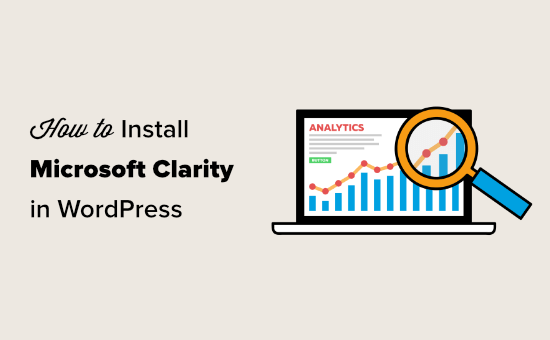
What is Microsoft Clarity and Why Use It?
Microsoft Clarity is a free analytics tool for websites. It helps you see the most popular pages on your website and how users click, scroll, and interact with those pages.
The most important feature of Microsoft Clarity is their data visualization. This includes click tracking, heatmap reports, session recordings, and more.
Heatmaps show a visual report of how users move their mouse, where they click, select or scroll.
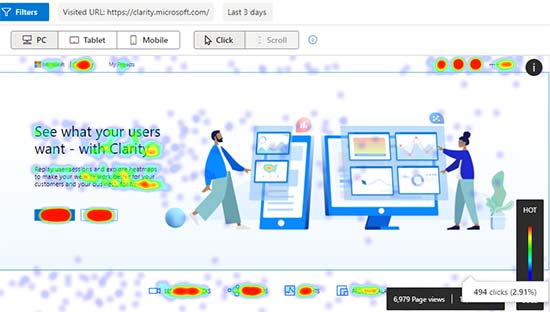
Similarly, session recordings help you see how users view your content, where they spend more time, and what takes them away from your WordPress website.
This information helps you create a better user experience for your users, improve performance, and boost sales conversion.
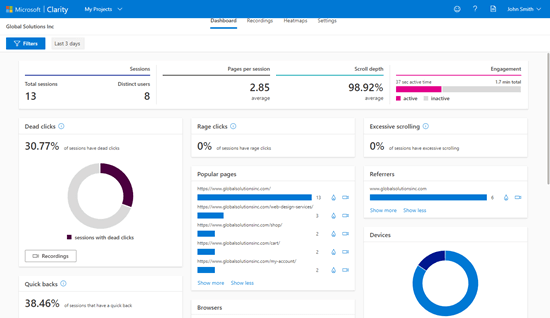
Microsoft Clarity vs Google Analytics – What’s the Difference?
Google Analytics is the best analytics solution on the market because it offers a lot of in-depth tracking features. Microsoft Clarity, on the other hand, focuses on the visualization of user interactions with heatmaps and session recordings.
Google Analytics helps you track almost anything on your website. It also has enhanced eCommerce tracking, conversion tracking, detailed reports, etc.
Microsoft Clarity is a new platform, and it’s currently not an alternative to Google Analytics’ far superior features. However, you can use Microsoft Clarity alongside Google Analytics to unlock features like heatmaps and visitor session recordings because Google doesn’t offer those features yet.
Before Microsoft’s analytics feature, many website owners would use paid heatmap solutions like Hotjar or CrazyEgg alongside Google Analytics, but now you have a free alternative to those tools.
We recommend installing Google Analytics on all your websites. After that, you can follow our guide below to install Microsoft Clarity in WordPress.
They both work along quite well without affecting your website’s functionality.
How to Install Microsoft Clarity Analytics in WordPress
It’s easy to add Microsoft Clarity to any website including your WordPress site. You’ll need to sign up for Microsoft Clarity, and then add a tracking code to your website.
We’ll take you through the process step by step.
Signing Up for Microsoft Clarity
First, head to the Microsoft Clarity website and click on the ‘Get Started’ button.
You need a Microsoft, Facebook, or Google account to sign up.
As soon as you sign up, you will see the Clarity dashboard with a popup to add a new project.
Go ahead and enter a name for your project. You can use the name of your website to make it easily recognizable. Next, enter your website URL and choose a site category.
Note: Clarity should not be used by finance, medical, or government-related websites.
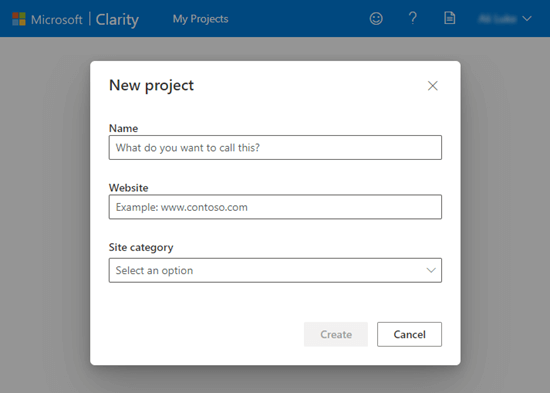
Once you’ve created your new project, it will then be listed in your dashboard.
You need to click on it to see the tracking code that you have to add on your site:
![]()
We recommend leaving this tab open or copy the code to a safe place. You will need it later in this tutorial.
Adding the Microsoft Clarity Code to Your WordPress Site
Micorosoft Clarity tracking code needs to be present on all pages of your WordPress website. Luckily, there is an easy and safe way to make it happen without editing any WordPress files.
First, you need to install and activate Insert Headers and Footers plugin. For more details, see our step by step guide on how to install a WordPress plugin.
This plugin lets you add any script in your website’s header or footer right from your WordPress dashboard (no FTP or cPanel needed).
Once the plugin is activated, go to the Settings » Insert Headers and Footers page in your WordPress admin area.
Now, you need to copy and paste the Microsoft Clarity code into the ‘Scripts in Header’ box.
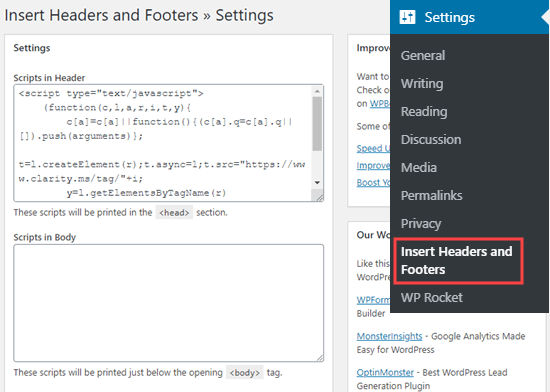
Don’t forget to click on the Save button at the bottom to save your settings.
The plugin will now automatically add the Microsoft Clarity analytics code to all pages of your WordPress site, so you can track website visitor activity on your website.
Pro Tip: If you’re using a WordPress caching plugin, then you need to clear your WordPress cache. This is important otherwise Microsoft will not be able verify your site for few hours.
Using Microsoft Clarity
Once you have installed the tracking code and cleared your WordPress cache, Microsoft will then start recording visitor session data.
However it will likely take up to 2 hours before you can see any results in your Clarity account.
Simply login to your Clarity account after a few hours, and you should be able to see activity summary in your dashboard.

Similar to Google analytics, Microsoft makes it easy to see which pages on your site are the most popular.
You can also see other useful insights like the percentage of sessions that have ‘dead clicks’. These are clicks that don’t go anywhere. For instance, users might be clicking on an image thinking that it’s a button or a link.
The dashboard also shows you the number of ‘quick backs’, which occur when a user moves off a page then very quickly comes back to it.
It also tracks excessive scrolling, when users scroll through a page more than expected.
Another useful statistic is rage clicks, when users rapidly click or tap in the same area. Paying close attention to these metrics can help you make your site more user-friendly.
The Recordings tab shows you recordings of different user sessions. You get the details of the user’s device, operating system, and country.
Clarity also tells you the number of pages they visited, the duration and time of their session, and the number of clicks they made.
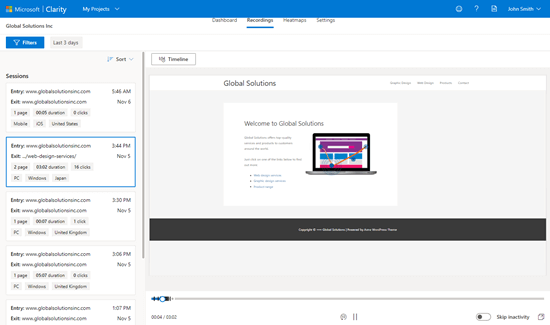
The recordings let you see where people are clicking on your site. In this example, the user has clicked multiple times on an image, perhaps expecting it to link to a page.
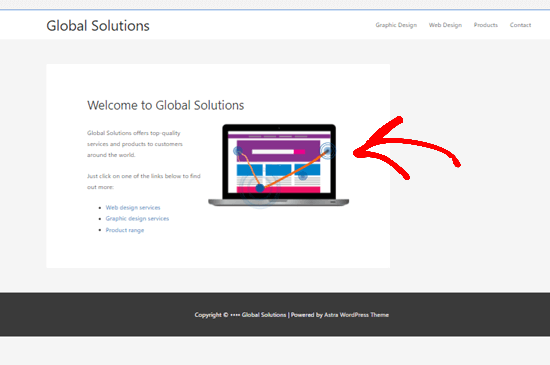
The Heatmaps tab shows you the heatmap of your website. These help you see which sections are popular on your site based on number of people clicking. For instance, in this heatmap on our demo site, we can see that people have tried to click on the email address on the contact page.
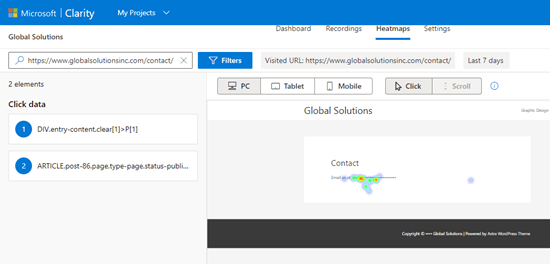
In the future, Microsoft Clarity also plans to show scrolling on the heatmaps.
Final Thoughts on Microsoft Clarity Analytics Tool
Microsoft Clarity is a new analytics tool with some neat features. While it’s no alternative to the powerful Google Analytics platform, it definitely offers some interesting features like free heatmap and session recording.
Often new website owners want to see heatmaps and session recording, but they don’t have the budget to purchase premium solutions like HotJar or CrazyEgg. Well, now you can use Microsoft Clarity.
Using the heatmaps and session recording, you should be able optimize your website or online store experience to improve user experience and boost sales.
We hope this article helped you learn how to install Microsoft Clarity Analytics in WordPress. You may also want to see our comparison of the best WordPress page builders to create custom layouts without any code, and our pick of the best email marketing services to grow your business.
If you liked this article, then please subscribe to our YouTube Channel for WordPress video tutorials. You can also find us on Twitter and Facebook.
The post How to Install Microsoft Clarity Analytics in WordPress appeared first on WPBeginner.

No comments:
Post a Comment